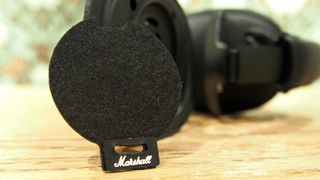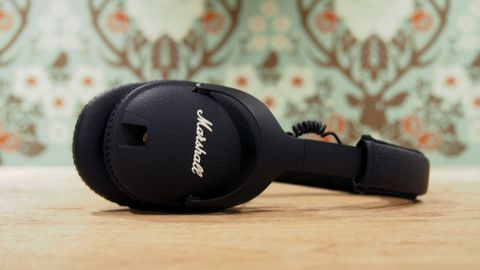TechRadar Verdict
Marshall checks the boxes required for a set of headphones to be worthy of your time. However, the lack of premium build materials and volume controls make the high asking price a little unreasonable.
Pros
- +
Signature design
- +
Full sound
- +
Comfortable
Cons
- -
Steep asking price
- -
Lacks volume controls
- -
Few premium materials
Why you can trust TechRadar
When you're in the market for a guitar amplifier, Marshall is probably among the first few names that rolls off the tongue. But when it comes to shopping for a set of headphones, this isn't necessarily the case. In fact, it might be news to you that Marshall is in the business of making cans at all.
Even if you aren't aware of the Marshall legacy in the rock world, its headphones deserve your attention. Specifically, its $200 (£170, AU$250) over-ear headphones known simply as Monitor.
These are designed with the same stellar attention to detail as seen in Marshall's stage audio equipment, and they possess impressive sound capabilities. Positives aside, you're getting charged a hefty premium for the namesake, and the skimpy set of inline controls are a disappointment.
Design
If you've ever used a Marshall amplifier for jamming out, you're probably aware of its premium design qualities. But it's quite alright if you've never heard of Marshall, allow me to explain what makes its products stand out.
Marshall amplifiers are recognized by their bold black appearance, offset with brass and white accents. They are usually coated in leather, or at least, a material that gives off a leathery look and feel. The speaker cabinets are covered in a fine metal mesh where, in its middle, the Marshall logo appears prominently. The Marshall Monitor is host to each of these features, and I admire how well the design has translated over to the headphone form factor.

Inside the headband, you'll find plenty of plush to ensure that you're comfortable while you listen. The textured and smooth leatherette material gives off a premium look, but the fact that it isn't real leather is a bit of a disappointment considering the asking price.
Tucked into the headband are the adjustable sidearms. These are made out of tough metal and spiffed up with a coating of matte black paint that doesn't scratch, so worries over its durability over time aren't necessary. Each sidearm stretches out thirteen notches from its original position and provides a true, one-size-fits-all experience. My large noggin came nowhere close to reaching the size threshold of the Monitor.

Alongside each of the sidearms are thin, coiled cables that stretch down into the ear cups with subtle, but charming brass touches. The cups attach to the sidearms with a mechanism that allows for tilting the cups up and down, but not side to side. The design flaw is offset by its ability to handily fold up the cups into the headband.
The outer section of the ear cups prominently feature textured plastic that's made to look like leather and just a hint of rubber, which makes up the striking logo. Each ear cup features a 3.5mm input, so the choice on which side you plug the included cable into is totally up to you. Speaking of the cable, it's coiled and detailed on each end to mimic a standard cable you'd use to link a guitar up to an amplifier.

The insides of the ear cups are cushioned with enough room inside to fit my ears without feeling cramped. The padding is held on by magnets and can be removed to access what Marshall calls its FTF (Felt Treble Filters). Remove these for more of a crisp sound, or keep them on for a bass-heavy, warm sound style.
Performance
Marshall hasn't remained in existence for more than 50 years based on looks alone. Thankfully, this trait also makes its way over to the Marshall Monitor over-ear headphones without compromise.
Sound performance (with or without the Felt Treble Filters) is full-bodied, packing in deep lows, mids that shine and highs that come through without a harsh, metallic effect. As much as they might seem to be a superfluous addition, the FTF actually do add a layer of warmth and bass to the sound. Conversely, without them, the sound doesn't suffer. Instead, it gains some points in crisp delivery and only loses out on a little richness on the low-end.

These headphones shine in every genre that I tested them. That ranges from jazz, hip-hop, rock and even a few podcasts in between. Not only do these scale well with different types of media, I found these to be versatile over-ear companions on-the-go and in the office. The folding design of the Monitor allows them to be tucked away into a small bag, and the comfort provided by the headband and plush ear cups allow for comfortable enjoyment.
The inline controls feature a microphone and a multi-function button that controls play, pause and can skip back and forth with a series of button presses. While this is an appreciated addition, its implementation feels half-baked without volume controls.
Final verdict
Fans of Marshall's stageside equipment will likely appreciate the design of the Monitor from the get-go. But what about everyone else? The brass and metal touches combined with textured plastic and leathery features are, altogether, more than enough to construct an appealing product.
However, barring the soulful sound performance and comfort, I expect premium build materials and volume controls from a set of headphones that cost $200. For a set of on-ear headphones in the same price range that fill in these pesky blanks, check out the Klipsch Reference.
That said, if you're keen on the style of the Marshall Monitor, I've seen them for sale on Amazon for as low as $115. For that price, these cans are a steal.
Cameron is a writer at The Verge, focused on reviews, deals coverage, and news. He wrote for magazines and websites such as The Verge, TechRadar, Practical Photoshop, Polygon, Eater and Al Bawaba.


